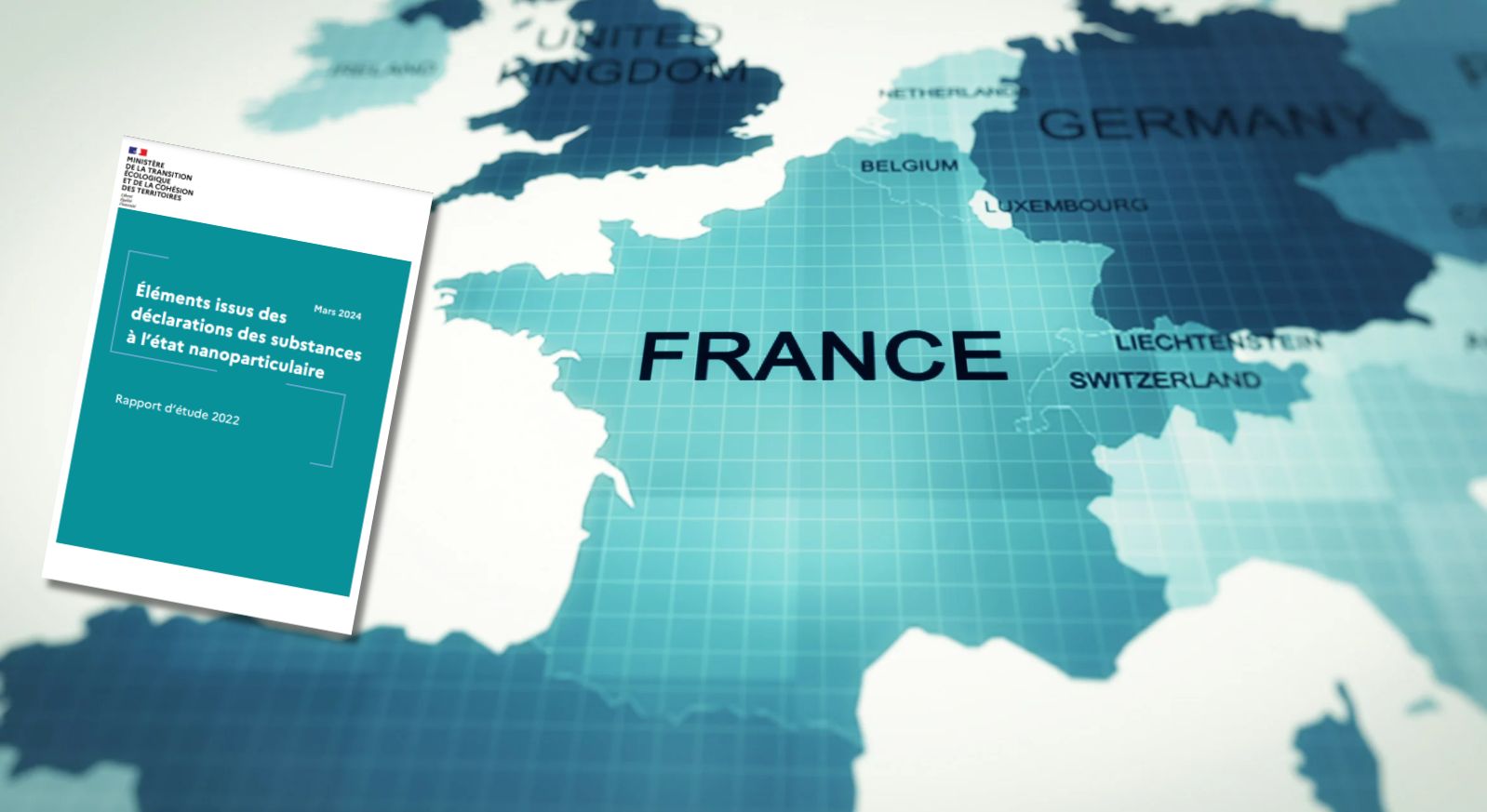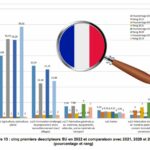
Increase in ‘made in France’ nanos: an artefact or a real trend?
The official report presenting the data collected on the r-nano portal in 2022 is finally online. In 2021, French nanos production returned to its pre-COVID level, while imports continued to decline. The 2023 report, still awaited, should confirm or invalidate this development, which is potentially linked to COVID and therefore open to question. Other data are relatively stable; in particular, agriculture remains the main sector in which nanos are used, ahead of cosmetics and construction. Attention companies and laboratories: the deadline for the 2024 declaration is April 30.
Figures expected for more than a year
One year after the simultaneous publication of the 2020 and 2021 reports, the 2022 report of the mandatory declaration of nanomaterials in the r-nano register was published on the French Ministry of Ecology website and on the Health & safety agency (Anses) website, more than a year late.1The Environmental Code requires that this data be made available to the public no later than six months after the deadline for reporting by industry, which in this case is May 1. The 2022 report should have been published in January 2023 (the reporting period having been extended to June 30, 2022).. The data in the 2022 report relate to nanoparticulate substances imported, manufactured or distributed in France in 2021. As expected, it is more precise and comprehensive than previous versions (1,015 page-long, it is actually twice as long as previous versions), thanks to improvements made last year to the form and information system.
The 300,000 tonne mark for nanos in France is reached again
A total of 307,301 tonnes is the total volume of nanos declared in 2022 for the year 2021. Although this figure is one of the most important for anyone interested in nanotechnology in France, it is unfortunately not in the report. You’ll have to wait until Appendix 1, on page 78, to find it2Even calculator wizards have to wait until page 68 to find the numbers that add up to the result.. In France, for 2021 :
– the total quantity of nanos produced was 236,548 tonnes, an increase of 18.7% compared to 2020 ;
– he total quantity of nanos nanos imported was 70,723 tonnes, a drop of almost 19% compared to 2020.
Whereas the previous year’s total volume had fallen to just 285,560 tonnes because of the health crisis linked to Covid-19, the overall volume has risen back above 300,000 tonnes, with more than 3/4 of nanos declared as produced in France and less than1/4 imported. The recovery in production levels should not, however, mask the fact that imports have fallen behind pre-crisis tonnages. It remains to be seen whether or not the figures for the 2023 balance sheet will confirm this trend, perhaps linked to the aftermath of Covid-19.
Little change in the main substances declared
The nanomaterials market in France has remained stable compared with previous years:
- 1,175 companies and laboratories located in France3(as in the previous year, over 90% of these were distributors) completed at least one declaration in 2022 (versus 1203 in 2021, a very slight decrease of 2%); the number of foreign reporting entities is very stable (around 80, as in the previous year).
- Just over 10,700 declarations were submitted in total in 2022 (compared with almost 10,600 completed by 1203), of which 10,127 were used in the balance sheet.
- 215 categories of chemical substances (CAS) have been listed.
The substances most produced and/or imported in 2021 remain unchanged, with a few variations in the order of ranking (which are difficult to assess, as volumes are not quantified precisely, but presented by tonnage band).
→ In quantities of over 10,000 tonnes, they are the most popular: 1 – carbon black ; 2 – silica ; 3 – titanium dioxide.
Next in order and in quantities ranging from 1,000 to 10,000 tonnes: calcium carbonate, vinylidene chloride, aluminum oxide, cerium dioxide mixed with zirconium dioxide, a red pigment and magnesium silicate.
The other declared substances represent tonnages of less than 1,000 tonnes.
Note: once again, less than 100 kg of nano-silver have been declared to the r-nano register, despite its alleged presence in a large number of products. This very low volume once again highlights the limitations of the mandatory declaration, which only covers nanosubstances produced or imported into France… What about nanosubstances contained in finished products imported into France? In other words, the nano-silver present in “anti-odour” socks imported into France (from Asian countries, for example, which are fond of nano-silver) is not covered by the declaration obligation and therefore not present in the r-nano register, even though it ends up in French wastewater after washing. As a reminder, the Anses had pointed out, as early as 20104Cf. Evaluation of the risks related to nanomaterials for the general population and the environment, Afsset (now ANSES), March 2010 the risks associated with the release of silver nanoparticles when textiles containing them are washed, as this has deleterious effects on aquatic fauna.
Agriculture is the main sector using nanos, ahead of cosmetics and construction
As in previous years, agriculture remains the most declared sector of use in terms of5number of declarations in 2022.
The most frequently declared product categories are :
1 – plant protection products*,
2 – cosmetics and personal care products,
3 – coatings and paints, solvents, thinners,
4 – “others
5 – inks and toners
6 – biocides (disinfectants, insecticides)
* The nature and quantity of nanoparticles used in agriculture remain unclear: they may be used in pesticides, fertilizers and seeds, but also in animal feed and veterinary medicines.
In an article published in Actu Environnement on March 7, ANSES mentions ongoing work on samples of nanoproducts to gain “an idea of their nature, their possible use and the risks they specifically present in this form”. This work, expected since 2018, was due to be presented in early 2023, but despite repeated requests from AVICENN, no information has yet been provided by the agency. However, the use of these products, often sprayed6outside industrial installations, is the leading process category in terms of the number of declarations (see pages 51 to 53 of the r-nano 2022 report), inevitably leads to the release of nanos into the environment, without information of the public – nor exposed farmers and local residents.
In the same article, a phenomenon of “over-declaration” of nanos in plant protection products is mentioned, which could be reassuring. However, this point needs to be further substantiated, in light of the promises and risks surrounding the use of nanos in agriculture.
Improvements to be presented by the end of the year
Initially scheduled for 2023, the results of the working group set up by Anses to improve the robustness and use of data from the r-nano registry have been postponed to early… and then late 2024. After several hearings organized over the past few months, the group will now summarize and formalize its recommendations.
Pending their publication, chapter 5 of the report highlights a number of important points, including :
- improved usage descriptors, necessary for a better understanding of nanos uses in France
- improving the data declared by foreign suppliers, which are too often incomplete (as a reminder, they are not covered by the declaration obligation): the poor quality of data declared upstream in the distribution chain is detrimental to the data available to downstream players.
→ French companies importing substances from abroad, with no assurance as to the quality of their physico-chemical characterization, like ANSES and more widely the French authorities, are dependent on the information provided (or not) by suppliers. As things stand at present, the only option in the event of missing or questionable data is to carry out tests to check the granulometry of the substances concerned.
AVICENN’s wishes
For years, AVICENN has been calling for more ambitious measures:
- Include, in the r-nano register, products containing declared nanos and make available to the public information on these products, as well as volumes by sector of use (agriculture, paints, cosmetics, food, etc.). This information is currently unavailable.7In the 2022 report, the tonnages of sectors of activity (NACE) are clearly specified (pages 43 and 44), but not those of sectors of use (SU), for which, on pages 45 to 47, only the occurrences (i.e. the number of declarations) are presented, which does not necessarily reflect the tonnage concerned.They would provide a better picture of the actual uses of nanoparticles, and help guide risk assessment work. and minimize potential unintentional exposure and environmental contamination resulting from their use.
- Access to data from the R-nano register is to be further extended so that all organizations and researchers working on nano-risk assessment and prevention can also have access to registry data, as requested for years by AVICENN and the French High Council for Public Health (HCSP).8Cf. Bilan des connaissances relatives aux effets des nanoparticules de dioxyde de titane (TiO 2) sur la santé humaine; caractérisation de l’exposition des populations et mesures de gestion, HCSP, April 2018 in particular. The HCSP obtained this right last year9Cf. Decree no. 2023-196 of March 22, 2023 concerning the availability of information obtained in application of articles L. 523-1 and L. 523-2 of the Environment Code, in accordance with action 13 of PNSE 4. However, access to the r-nano register is still far too restricted: at research level, for example, neither INSERM, CNRS, INRAé nor CEA have access to it, let alone doctors and other prevention specialists, let alone local residents, environmental or consumer associations, trade unions or AVICENN…
Conversely, enquiries for confidentiality have increased with 157 declarations for which at least one request for confidentiality has been filed in 2021 (nearly 80 requests concerning the uses of nanos declared and nearly 65 requests concerning the names of chemical substances in nano form – i.e. five times more than when r-nano first came into force). How many were accepted? The report doesn’t say.
- Workers exposed to nanos should be automatically registered in the EpiNano epidemiological scheme monitoring workers exposed to nanomaterials: for the past ten years, the cohort has not been properly set up, due to a lack of company directors willing to play along… because the system is not mandatory, but based on voluntary participation!
What’s next?
The 2023 report, which should have been published at the end of 2023, is currently being finalized by ANSES and will be published once it has been validated by the French Ministry of Ecological Transition .
With regard to the 2024 declarations, companies and laboratories have until April 30 May 31 to complete them on the dedicated website https://r-nano.fr managed by ANSES.
[This article was updated after the deadline of April 30 was postponed to May 31].

Les prochains RDV nano

- Webconference for analysis laboratories, plant fertilizer manufacturers and distributors, public authorities…
- Moderated by David Krupka, nanotechnologies development manager at AFNOR Normalisation and Emilie Langlois-Bertrand, nantechnologies standardization project manager.
- In partnership with Armand Masion, CNRS Research Director, and Sandrine Mocoeur, Health, Safety, Environment and Quality Manager at SYNGENTA.
- This exchange will also be an opportunity to explore the creation of a national platform to identify standardization needs.
- Website: www.afnor.org/evenement/nanotechnologies-agriculture-cadre-pratique-responsable/
- 20th meeting of the “nano and health” dialogue committee
- Organizer: ANSES
- Training intended for occupational physicians, occupational risk prevention specialists (IPRP), company prevention specialists, prevention department staff from Carsat, Cramif and CGSS, institutional prevention specialists (Dreets, Dreal, MSA…).
- Organizer: French National institute of research and security (INRS)
- October 5 to 9, 2026
- Website: www.inrs.fr/…/formation/…JA1030_2026
Notes and references
- 1The Environmental Code requires that this data be made available to the public no later than six months after the deadline for reporting by industry, which in this case is May 1. The 2022 report should have been published in January 2023 (the reporting period having been extended to June 30, 2022).
- 2Even calculator wizards have to wait until page 68 to find the numbers that add up to the result.
- 3(as in the previous year, over 90% of these were distributors)
- 4Cf. Evaluation of the risks related to nanomaterials for the general population and the environment, Afsset (now ANSES), March 2010
- 5number of declarations
- 6outside industrial installations, is the leading process category in terms of the number of declarations (see pages 51 to 53 of the r-nano 2022 report
- 7In the 2022 report, the tonnages of sectors of activity (NACE) are clearly specified (pages 43 and 44), but not those of sectors of use (SU), for which, on pages 45 to 47, only the occurrences (i.e. the number of declarations) are presented, which does not necessarily reflect the tonnage concerned.
- 8
- 9



